
In the River TAKAHARA --Vol.78--
Colour Orange of Dunkeld
In the middle of August in 1987 Mr. Hiraiwa of Okazaki City guided me to the source area of the River Kiso. He and I had been fishing together since the early days of cherry salmon fishing in Japan. We knew each other very well. (See vol.44 and vol.62)
Royal Coachman’s colour combination makes fish mad, whether you like it or not.
Our destination was the source area of the River Ohtaki, which is a main tributary of the River Kiso. Many years before I once went fishing to the River Ohtaki when I traveled from the main stream of the River Kiso across Lake Ontake and fished amago trout in and around the River Ugui, a main tributary of the River Ohtaki. Now our destination was a creek that flowed into Reservoir Miure, which lay at the source area of the River Ohtaki, farther upstream of the River Ugui.
Avoiding a too long way along the River Ohtaki, we climbed the mountain by bike from Kashimo village in Gifu Prefecture to go directly to the source area. We enjoyed our bike tour. The Kurakake Pass of 1600m height lay in the middle of a primeval beech forest. It was very cool for August morning. Once we crossed the ridge to Nagano Prefecture, we were surrounded by Japanese cypresses, which made me feel that we had finally come to Kiso.
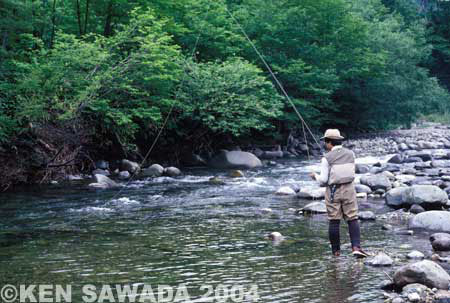
Gentle stream spread for some distance at the upper reaches of the dam.
We arrived at Reservoir Miure and made a detour to go to our destination, the source area of the main stream. The dam had been built in the River Ohtaki, where both char and amago trout were living together. The fish that grew up in the dam came upstream to the creek in autumn. Our plan was to fish them.
Probably it was about 9 a.m. We started from the head of the pool of the dam and went upstream. The creek had rather low water and a small amount of water seemed still smaller than usual. The gentle and flat stream spread for some distance. There were only pebbles and no place of rest for the fish which had come upstream. Then as both banks drew nearer, the river became narrower and big stones appeared. Finally we got to the fishing point but there was no sign of fish.
It was in the middle of August even in high area. I decided to use the wet fly although the dry fly seemed to be also effective. As Mr. Hiraiwa chose the dry fly, we could easily know how fish would respond to each fly. How helpful a fishing companion is!

At a small waterfall Mr. Hiraiwa fished at the opposite bank of the head of the pool.
Usually the fish coming upstream in autumn prefer rather big and bright-coloured flies, whether dry or wet flies. I chose size 6 Parmachene Belle as a dropper and size 6 Dunkeld as a lead fly. I put them to 2X leader of 7ft. 6in. Both flies were extraordinary bright-coloured. Although I had not had so much experience, I had caught big yamame trout in the beginning of autumn with those two flies and also the combination of Royal Coachman and Queen of the Waters.
The stream became good looking but there was still no sign of fish. Our dry and wet flies just drifted down without touching anything.
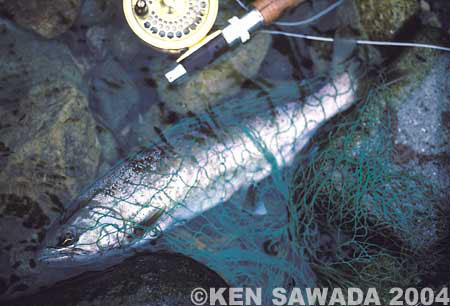
Half a body was covered with silvery scales even in autumn. Thin as it is, it came upstream from the dam.
A Small Waterfall
Then the river made a right-angled turn and a small waterfall appeared. The height was only 1.5m from the top to the bottom. In high water fish would easily go beyond it. But now its head of the pool looked nice. As big rocks were pushed out from the both banks, the basin of the waterfall, even if a small one, gave a good hiding place to fish. This place would be convenient for fish to wait for high water to go farther upstream.First the dry fly of Mr. Hiraiwa passed the basin of the waterfall like a channel. The fly drifted in a beautiful shape, twice or third time but there was no response. There had been no sign of fish so far. There seemed to be no expectation at this point from now on, either, judging from the weather. At low water now, this spot would be an obstacle to the fish that had come upstream from the dam.
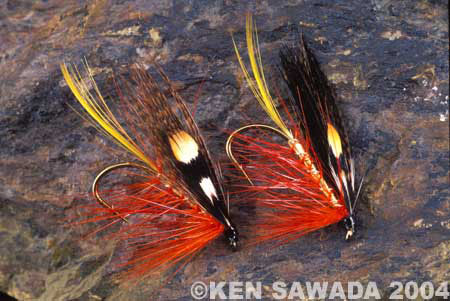
Dunkeld was the first fly that every angler chose as an orange fly.
He cast the dry fly another several times in vain. Then it became my turn to cast the wet fly. I made it drift in the centre of the head of the pool, just like him. I tried 3 times. No response.
If there is no fish in this head of the pool it is quite natural that we do not get any bite. But if there are some fish that do not respond to our flies, they will stay under the bubbles around the water-falling point. I wanted to send my fly there. I reeled out the line and cast it to the falling water to drive the whole leader into it.
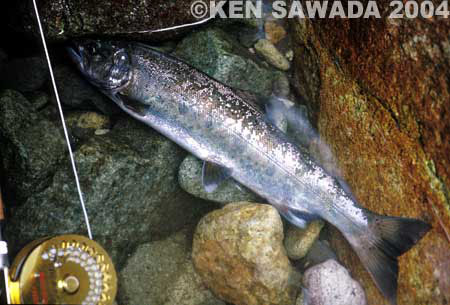
This fish had quite different shapes of the body and the tail from those grown up in the river.
The end of the fly line stopped and floated on the water-falling point. I believed that my two flies and the leader of 7ft 6in got to the bottom of the small basin of the waterfall. I waited for a while. Then the fly line came drifting towards me slowly. My flies that went down to the bottom must come together, so I thought. I would give up if I got no bite now. Is there really no fish?
I came to myself when I got a strong bite with thud. As soon as I raised the rod the fish ran to right and left in the head of the pool. It was not heavy but its pull was strong. I pulled up the fish carefully to the surface and scooped it into the net. It was an amago trout. Bright red small spots were scattered on its olive-brown body. Its colour, face and body shape, all were different from that fish in other rivers. All those features are typical of this area? It was thin, which made it look small, but it was 36cm long.
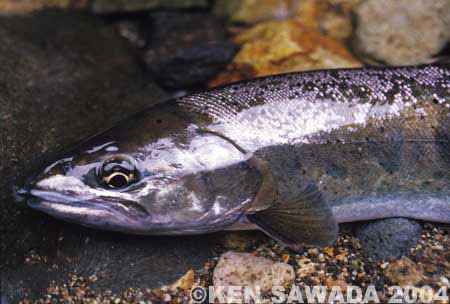
It looked like a yamame trout but there were small red spots under scales.
Char in the River Kiso
Finally I had found a fish. Some fish must stay upstream. As far as I could see upstream the stream looked nice.For another half an hour we went farther upstream, full of happy expectations. It was true that the stream looked much better than the lower reaches but no fish came up. Nearly 3 hours passed from the start. Then we got to a big sliding waterfall. Although its height was 5m, the fish that had come from the dam lake probably could not go farther upstream. That meant we would have no chance of finding big amago trout that had gone upstream even if we went farther upstream along this creek. Looking at the sliding waterfall, we ate our lunch boxes.
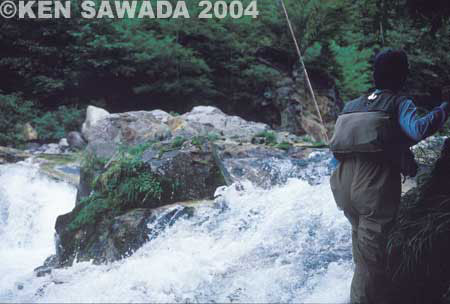
Going over the sliding waterfall, we headed upstream.
So far we had found some footprints and grasses trodden on. It was the middle of August, a little early for the peak season when fish went upstream but not too early. We had not met other anglers yet but probably not a few of them came to this creek to aim at the fish that going upstream. Ah bad timing!
Talking in this way or that, we finished our lunch. It was too early to return downstream because we had a precious chance of going upstream quite far in the big river. We decided to go ahead.

This char looked like a salamander
We went over the first sliding waterfall just to find another one. It was gently-sloping enough to go over but not a comfortable place for fish to live in. Expecting the stream to be better for fishing, we headed farther upstream. But sliding waterfall appeared one after another and there was no hope for good spot.
Just before giving up and returning downstream, I found a little channel in front of the next sliding waterfall. I decided to fish it as my last spot. I cast the same flies although I thought those to be a little bigger for the size of the channel. The flies settled on the calm surface. Immediately something appeared in the ripple.
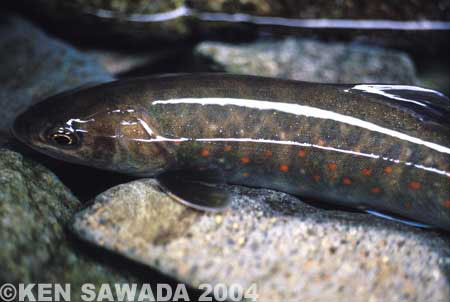
Snake-like expression, smooth skin and bright red spots were typical of char in this creek.
Surely something came up to bite the fly. Taking a breath, I slightly raised the rod. I felt a soft pull. What pulls my line? No doubt it is a fish. Walking to the waterside, I retrieved the line. Then I held the leader and lifted the fish together with the fly in its mouth. It had a round head and at first looked like a goby or a sculpin. Then I saw it lying on the waterside. I was excited.
“How beautiful!” Bright-red spots, instead of orange ones, attracted attention. I had never seen such bright spots of char. This char had exceptionally bright colour probably because of special circumstances of this area. This area must have been cut off from other areas. I just stared at it through the finder, forgetting to press the shutter release button.
-- To be continued --
- NET SHOP INFORMATION

SL6 Black Spey Hooks
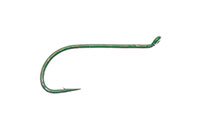
DU3 Limerick Spinner Hooks
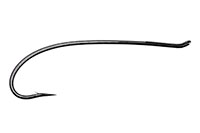
SL4 Single Bartleet Hooks
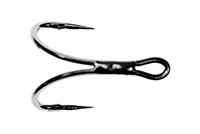
XD1 Tube Fly Double Hooks

DD2 Flat Perfect Hooks
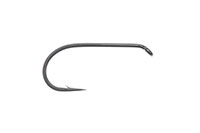
DD1 Black Terrestrial Hooks
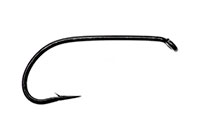
TD4 Old Limerick Wet Hooks

DU1 Silver May Hooks

MU1 Flat Midge Hooks

LD3 Long Limerick Hooks

TD2 Summer Sproat Hooks
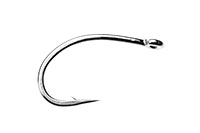
XS1 Tube Single Silver Hooks

TD6 Siver Sedge Hooks

SL5 Black Spey Hooks

DU3 Limerick Spinner Hooks
- TROPHY CLUB
- FLY SHOW
- EXHIBITION
- MASTERS`
- FLY DRESSING CONTEST Archives
- TRAVELLER Archives
- TACKLE IMPRESSIONS Archives
- ANGLERS` PHOTO GALLERY Archives
- ----------------------------------------------
- トロフィークラブ
- フライショー
- エキシビション
- マスターズ
- フライドレッシング・コンテスト・アーカイヴ
- トラヴェラー・アーカイヴ
- タックル・インプレッション・アーカイヴ
- アングラーズ・フォトギャラリー・アーカイヴ
株式会社サワダ 185-0021 東京都国分寺市南町3-13-4
SAWADA'S INC. 3-13-4 Minamicho, Kokubunji, Tokyo 185-0021, Japan
写真・ドキュメントの無断転載を禁じます。
All the images and documents found on this site are owned by Ken Sawada and may not be used without permission.
But, link to this site is FREE.
Copyright © 2000 - 2025 SAWADA'S INC.. All rights reserved.
SAWADA'S INC. 3-13-4 Minamicho, Kokubunji, Tokyo 185-0021, Japan
写真・ドキュメントの無断転載を禁じます。
All the images and documents found on this site are owned by Ken Sawada and may not be used without permission.
But, link to this site is FREE.
Copyright © 2000 - 2025 SAWADA'S INC.. All rights reserved.
